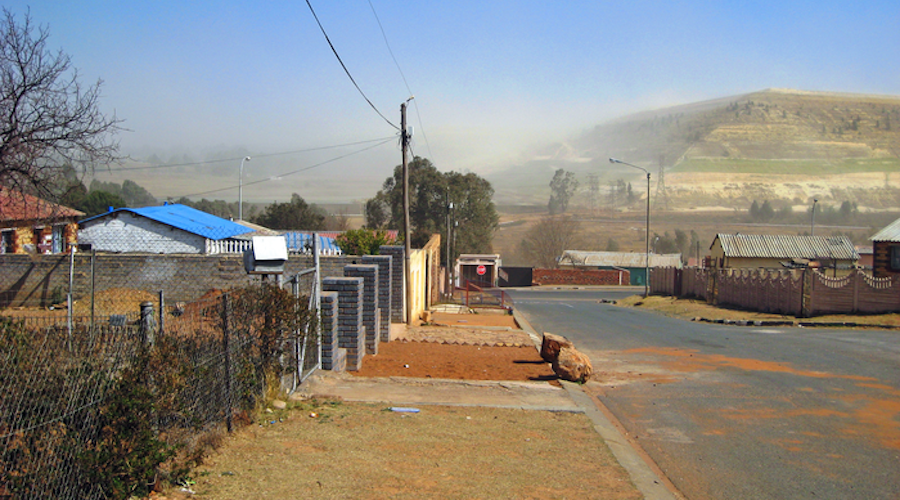Staff Writer | May 19, 2022

Homes situated next to mine dumps in Johannesburg, South Africa.
(Image courtesy of Angela Mathee/SAMRC).
An international team of researchers is analyzing individual hair samples from people living and working around the Witwatersrand basin near Johannesburg to determine the degree of uranium contamination and identify which populations are most at risk.

This South African region is known for hosting the world’s largest gold deposit which, when mined, releases harmful, toxic and radioactive waste as a byproduct.
“In a preliminary study, we have already detected elevated uranium levels in the hair samples of individuals living in the vicinity of mine dumps and tailings dams in the region,” Susanne Sachs, one of the scientists involved in the research, said in a media statement. “We now wish to pursue the question of how the measured uranium concentrations relate to the geographic and demographic conditions.”
An estimated 1.6 million people of different social and ethnic backgrounds live in the vicinity of mine waste deposits. Many of them are unaware of the dangerous substances that surround them.
According to Sachs, this is especially the case for children and adolescents from whom South African researchers collected hair samples during the first phase of the study—both from the exposed regions and from a control group with no exposure.
Long exposure periods
Hair is suitable as sample material because the heavy metal concentrations measured in such samples are also representative of longer periods of previous exposure, unlike blood or urine samples. Hair also provides information on whether heavy metals have entered the bloodstream.
To facilitate later comparison of the samples, the researchers also record essential information about the child, including weight and height measurements, age, sex, occupation of the parents, health status, sources of water, presence of animals and home-grown foods, and other factors.
Researchers analyze environmental samples, including soil and dust from the surrounding environment, and take into consideration that the predominant wind direction in regard to the mine waste deposits can play a role in determining uranium exposure.
Once the samples are collected, they are sent to Germany, where they are analyzed in the Helmholtz-Zentrum Dresden-Rossendorf and VKTA laboratories.
In detail, the samples are ground, homogenized, purified and digested to obtain a solution that can be analyzed by means of a mass spectrometer.
The instrument separates the elements contained in the solution according to their atomic masses and determines the uranium content down to the microgram. The measured results are then evaluated together with the collected demographic data as well as with the uranium content of the environmental samples and other factors.
“From the results of the study, we hope that we can better understand uranium exposure pathways and that associated health risks for the population can be more reliably estimated,” Sachs said. “The study can also help in developing new regulations to ensure that the local population is better protected.”
An international team of researchers is analyzing individual hair samples from people living and working around the Witwatersrand basin near Johannesburg to determine the degree of uranium contamination and identify which populations are most at risk.

This South African region is known for hosting the world’s largest gold deposit which, when mined, releases harmful, toxic and radioactive waste as a byproduct.
“In a preliminary study, we have already detected elevated uranium levels in the hair samples of individuals living in the vicinity of mine dumps and tailings dams in the region,” Susanne Sachs, one of the scientists involved in the research, said in a media statement. “We now wish to pursue the question of how the measured uranium concentrations relate to the geographic and demographic conditions.”
An estimated 1.6 million people of different social and ethnic backgrounds live in the vicinity of mine waste deposits. Many of them are unaware of the dangerous substances that surround them.
According to Sachs, this is especially the case for children and adolescents from whom South African researchers collected hair samples during the first phase of the study—both from the exposed regions and from a control group with no exposure.
Long exposure periods
Hair is suitable as sample material because the heavy metal concentrations measured in such samples are also representative of longer periods of previous exposure, unlike blood or urine samples. Hair also provides information on whether heavy metals have entered the bloodstream.
To facilitate later comparison of the samples, the researchers also record essential information about the child, including weight and height measurements, age, sex, occupation of the parents, health status, sources of water, presence of animals and home-grown foods, and other factors.
Researchers analyze environmental samples, including soil and dust from the surrounding environment, and take into consideration that the predominant wind direction in regard to the mine waste deposits can play a role in determining uranium exposure.
Once the samples are collected, they are sent to Germany, where they are analyzed in the Helmholtz-Zentrum Dresden-Rossendorf and VKTA laboratories.
In detail, the samples are ground, homogenized, purified and digested to obtain a solution that can be analyzed by means of a mass spectrometer.
The instrument separates the elements contained in the solution according to their atomic masses and determines the uranium content down to the microgram. The measured results are then evaluated together with the collected demographic data as well as with the uranium content of the environmental samples and other factors.
“From the results of the study, we hope that we can better understand uranium exposure pathways and that associated health risks for the population can be more reliably estimated,” Sachs said. “The study can also help in developing new regulations to ensure that the local population is better protected.”
No comments:
Post a Comment